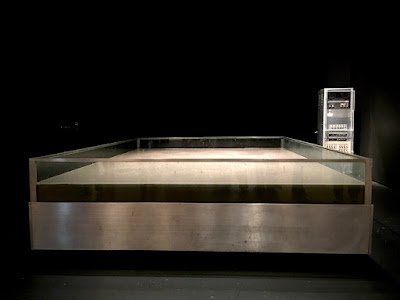III: Rauschenberg Among Friends
The Robert Rauschenberg Among Friends exhibit at the Museum of Modern Art was truly a showcase of Rauschenberg’s exploration and experimentation with the artists around him, his insatiable curiosity, and his sentimental almost scrap-booking style of art making. The overall impression given by a lot of the work in the exhibition was that of work that is very personal, practically autobiographical. The work read like diary entries that recorded the experience of collaboration with friends.
The influence of Duchamp on Rauschenberg’s work is clear as demonstrated by his use of found objects and is duly noted in the exhibition by the inclusion of “Bottle Rack” (1960) that was signed and inscribed by Marcel Duchamp. This influence that likely started at Black Mountain College caused Rauschenberg to begin making his first notable works. All of these works, not surprisingly, explored the boundary on what art can be and/or how art can be made, as well as perhaps surprisingly, were without exception, collaborative. One may consider collaboration a rather non-Duchampian practice as he is seen as a nearly peerless omnipotent power, but in reality, Rauschenberg may have been taking a page out of Duchamp’s Dada book as it was common practice in the movement to have Dada pow-wows at cafés or an ongoing discussion about art with peers through Dada publications and Dada public gatherings.
As aforementioned, Rauschenberg’s work at Black Mountain College was basically entirely collaborative. He did his “White Paintings” (ca. 1951) with the help of fellow students and future famous artists and did his exposed blueprint monoprints (ca. 1951) with, his then girlfriend, Susan Weil. Both of these works are pushing the typical boundaries of what art can be and how can art be made but at the same time are almost more documents of “a collaborative art endeavor with friends” or perhaps a documentation of a performance. These works can be seen as “that time my friends and I painted a canvas white” or “that time I laid out in the sun with my girlfriend” and these activities can be seen as performance. It is in this way that most of the work seen at the exhibition was sentimental. Even the work that is not explicitly collaborative has a way of documenting his life and relationships with others. Take for instance the Cy Twombly-esque treatment of the pencil on the pillow in Rauschenberg’s “Bed” (1955) hinting at his friendship with Cy Twombly and his actual life as a poor artist with his supposedly actual humble single bed.
Rauschenberg’s work “Automobile Tire Print” (1953) can be seen as a print or the documentation of a performance that Rauschenberg did with composer John Cage one day where Rauschenberg directed Cage to drive his car through a pool of paint and over a long strip of sheets of paper glued together. Rauschenberg’s “Scatoli Personale” (1953) are perhaps interesting for the reason that they document the experience of Rauschenberg and Twombly, two artists, traveling around Europe and picking up rocks and dirt along the way. These seemingly unimportant contents have a sentimental value to Rauschenberg as they are souvenirs of a trip with a dear friend and perhaps that is a part of what Rauschenberg defines as art, objects of value to artists.
Rauschenberg’s exploration into technique and collaboration culminates in an astonishing and completely unexpected work in one of the last galleries called, “Mud Muse” (1968-71). He created “Mud Muse” with his friend, Billy Kluver from Bell Laboratories as a part of the Experiments in Art and Technology (EAT). In this case the collaboration involved recent engineering innovations where technology paired sound with movement. A large vat of high viscosity driller’s mud, like the mud in the oil drilling fields from Rauschenberg’s home state of Texas, bubbles, spurts and makes sounds. Compressed air inlets in the vat are activated by sound signals in the exhibition space, which then make the mud erupt and bubble even more. The mud interacts with the chance operation of randomly sourced sound effects; creates an unpredictable pattern of movement; then increasingly adds to the accumulation of sounds and movement through interaction with the newly produced sounds that create a constant state of flux and evolution. The mud feels primordial yet is paired with new technologies. The juxtaposition of unusual outdoor materials brought inside paired with sound and movement is captivating. This was maybe the most interesting work in the exhibit because it combined pretty much all of the themes Rauschenberg has in his work. There was the familiar and unexpected material, the new way of making art, the equivocation between high and low, the element of chance, and of course, collaboration.
#hadpratt, #hadsopratt, #hadstories, #hadhistoryofsculpture



Comments
Post a Comment